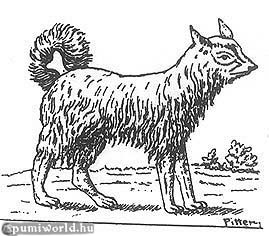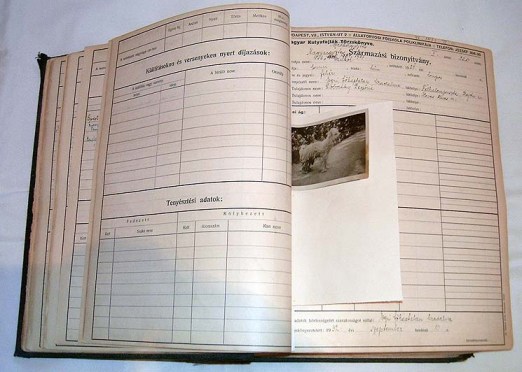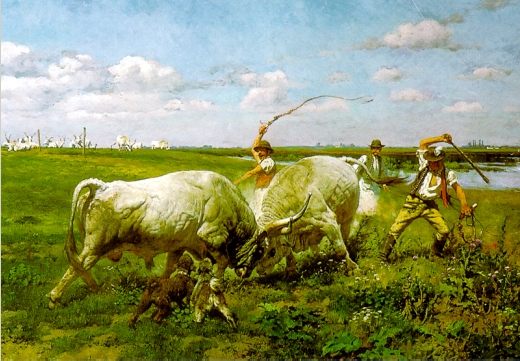ORIGIN
The name «Pumi» is first mentioned in 1815, describing a kind of sheep dog. For a century the word «Pumi» was confused with the word «Puli». In certain parts of Hungary the name Pumi was more frequently used, while in others, Puli was more common. «Pumi» may have derived from «Puli». The breed emerged about the 17th or 18th century probably as a result of cross breeeding German Spitz, French Briard sheep dogs, a variety of Terriers and Hungarian Puli. This cross breeding produced dogs whose coat was shorter and more wiry than of the Puli, whose head was more elogated, who had semi-pricked ears, erect with thi tips bent forward. These dogs had an unusually lively temperament and proved to be great help in herding sheep and rounding up cattle.

The Pumi in 1815.
Expertts in dog breeding noticed the centure-old confusion between Pulis and Pumis. It was Raitsits who defined the real difference between the original type of Puli and the Pumi. The latter breed appeared long after Pulis bacame a separate breed. Raitsits alsódiscovered that the basic differences can be furtheremphasized by careful breeding. Separate breeding of Pulis and Pumis started at the begining of the 20th century. Separation had a different effect on each of the two types. Pulis quickly became fashionable and were taken up by selective specialist breeders, while Pumis ecelled as working dogs. The breeding of Pumis still requeres a lot of skill and knowlwdge. Dogs bred in the country by shepherds are often more typical examples of this breed than any of the carefully bred pedigreed Pumis. The breed offers an interesting challenge to the enthusiastic student of canine hereditary traits. In 1921, while working on the standard description of the different Hungarian bred dogs, Raitsits suggested the need to consider Pumis as a separate breed. Pumis were classified as a regional variety of the Pulis at a show in 1920, while in 1923 they apper as an independent breed. The first outline for a standard description dates back to 1921. Entries in The Pedigree Book of Hungarian Dogs show how popular this breed bacame in the years following official recognition. In 1924 there were 265 entries for Komondors, 458 for Kuvasz, 255 for Pulis and 130 for Pumis (over half the number of Pulis enered). Dr. Csaba Anghi mentions that at a dog show in Budapest in 1927, out og 300 contestants there were 19 Komondors, 28 Kuvasz, 35 Pulis and 12 Pumis.

Second volume of the Pedigree Book of Pumi, 1932—1937
The separation of Pulis and Pumis took a long time to accomplish. Carefully planned selective breeding in the last 80 years is directed towards eliminating all overlapping characteristics of both breeds.

Painting from the begining of the 20th century
by Géza Vastagh (1866-1919) «Fighting bulls»
Móra Ferenc Múzeum - Szeged
Written by dr. Imre Ocsag